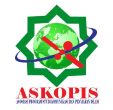Intensification of New Media Against the Spread of Fake News in the Post Truth Era
Abstract
Digital developments through new media trace progress in the transformation of knowledge in digital format. The transformation of media into public consumption is a catalyst for many changes in the digital world, besides that, social media innovation has also become fertile ground for the spread of fake news throughout the world, thereby catalyzing the formation of the post truth era. The aim of the research is to determine the impact of the intensification of social media on the spread of fake news in the post truth era. This research uses a qualitative method with a literature review approach where the data source is adopted from several data that have been verified and have continuity with the research object. Based on the analysis results, there are 35 articles with related objects, the data is transferred to the Ms file. Excel and the main aspects lie in authorship patterns, contribution distribution by country, author ranking, affiliate contributions and country distribution. The results of the analysis of 35 articles from 2017 to 2020 revealed that there were 44 authors using journals with related topics. The most widely used research method in this topic is quantitative. The keywords used by the author are "New media", "Fake news", and "Post truth". The contribution of this journal identification can help researchers and people around the world to be more careful in consuming information
Keywords
Full Text:
PDFReferences
Aldwairi, M., & Alwahedi, A. (2018). Detecting fake news in social media networks. Procedia
Computer Science, 141, 215–222. https://doi.org/10.1016/j.procs.2018.10.171
Amelia, F., Kamalludin, K., & Syarah, M. M. (2020). Peran media baru dalam kegiatan hijrah fest.
Komunika: Journal of Communication Science and Islamic Dakwah, 4(1), 1-9.
Anisa, R. Prihandini, P C., & Risanti, D. (2021). Hoax Information on social media in post truth era.
Conference.Loupiasconference.Org,355–363
http://conference.loupiasconference.org/index.php/ICoGEMT/article/view/175
Ar Razy, M. R. O., & Zakaria, M. M. (2021). Truth dan post truth dewasa ini. sosfilkom : Jurnal Sosial,
Filsafat dan Komunikasi, 15(02), 19–35. https://doi.org/10.32534/jsfk.v15i02.2293
Bhaskaran, H., Mishra, H., & Nair, P. (2017). Contextualizing fake news in post-truth era: journalism
education in india. Asia Pacific Media Educator, 27(1), 41–50.
https://doi.org/10.1177/1326365X17702277
Brownlee, B. J. (2018). Mediating the Syrian revolt: How new media technologies change the
development of social movements and conflicts. In The Syrian Uprising (pp. 188-206).
Routledge.
Chair, B. M., & Adzfar, Z. (2021). Kebenaran di era post-truth dan dampaknya bagi keilmuan akidah.
Fikrah, 9(2), 265. https://doi.org/10.21043/fikrah.v9i2.12596
Cheng, L., Guo, R., Shu, K., & Liu, H. (2021). Causal understanding of fake news dissemination on
social media. Proceedings of the ACM SIGKDD International Conference on Knowledge
Discovery and Data Mining, 148–157. https://doi.org/10.1145/3447548.3467321
Intensification of New Media Against the Spread of Fake News in the Post Truth Era
Vol. I (2) July- December 2023
SEMANTIK: Journal of Social, Media, Communication, and Journalism
Collins, J. (2019). “The facts don’t work”: The EU referendum campaign and the journalistic
construction of ‘Post-truth politics.’ Discourse, Context And Media, 27, 15–21.
https://doi.org/10.1016/j.dcm.2018.04.009
Douai, A. (2019). Global and Arab media in the post-truth era: Globalization, authoritarianism and fake
news. IEMed: Mediterranean Yearbook, 2(2), 124–132.
Faturahmi, N. I. (2020). Peran lembaga informasi dalam era post-truth. Berkala Ilmu Perpustakaan Dan
Informasi, 16(2), 239-252. https://doi.org/ 10.22146/bip.v16i1.151
Futuhal, N., & Fuad, A. J. (2020). Dampak post-truth di media sosial. Jurnal Pendidikan Dan Studi
Keislaman, 10(3), 376–388.
Gumilar, G. (2017). Literasi media: Cerdas menggunakan media sosial dalam menanggulangi berita
palsu (hoax) oleh siswa SMA. Jurnal Pengabdian Kepada Masyarakat, 1(1).
Harjuniemi, T. (2022). Post-truth, fake news and the liberal ‘regime of truth’ – The double movement
between Lippmann and Hayek. European Journal of Communication,37(3),269–283.
https://doi.org/10.1177/02673231211046784
Hartono, D. (2018). Era Post-Truth : Melawan hoax dengan fact checking. Prosiding Seminar Nasional
Prodi Ilmu Pemerintahan 2018, 70–82. http://repository.fisip-untirta.ac.id/952/
Hülcen Dönmez, A., Aydin, F., Kayali, N., & Yalçinkaya, B. (2018). a survey about university students
perception of post-truth on social media. Journal of Awareness, 3(4), 53–64.
https://doi.org/10.26809/joa.2018445555
Islam, M. S., Sarkar, T., Khan, S. H., Kamal, A. H. M., Hasan, S. M., Kabir, A., dan Seale, H. (2020).
COVID-19–related infodemic and its impact on public health: A global social media analysis.
The American Journal of Tropical Medicine And Hygiene, 103(4), 1621.
Jatmiko, M. I. (2019). Post-truth, media sosial, dan misinformasi: pergolakan wacana politik pemilihan
presiden indonesia tahun 2019. Jurnal Dakwah Tabligh, 20(1), 21-39.
Jaques, C., Islar, M., & Lord, G. (2019). Post-Truth: Hegemony on social media and implications for
sustainability communication. Sustainability, 11(7), 2120. https://doi.org/10.3390/su11072120
Krasni, J. (2020). How to hijack a discourse? Reflections on the concepts of post-truth and fake news.
Humanities and Social Sciences Communications, 7(1), 1–10. https://doi.org/10.1057/s41599-
-0527-z
MacKenzie, A., & Bhatt, I. (2020). Opposing the power of lies, bullshit and fake news: the value of
truth. Postdigital Science and Education, 2(1), 217–232. https://doi.org/10.1007/s42438-019-
-2
Cibaroğlu, M. O. (2019). Post-truth in social media. Arşiv Dünyası, 6(2), 87-99.
Miroshnichenko, A. (2017). The post-truth world : how social media destroy the absolutism of
the“objective” truth. human as media.
Molyneux, L., Lewis, S. C., & Holton, A. E. (2019). Media work, identity, and the motivations that
shape branding practices among journalists: An Explanatory Framework. New Media & Society,
(4), 836-855.doi: 10.1177/1461444818809392
Moravec, P. L., Minas, R. K., & Dennis, A. R. (2019). Fake news on social media: People believe what
they want to believe when it makes no sense at all. MIS quarterly: Management Information
Systems, 43(4), 1343–1360. https://doi.org/10.25300/MISQ/2019/15505
Mróz, A. (2017). The post of post-truth in post-media. about socio-situational dynamic information.
Kultura I Historia, 32(2).
Mudawamah, N. S. (2018). Membekali diri untuk menghadapi fenomena post-truth. IJAL (Indonesian
Journal Of Academic Librarianship), 1(3), 21–28.
http://journals.apptisjatim.org/index.php/ijal/article/view/51
Muqsith, M. A., & Pratomo, R. R. (2021). The development of fake news in the post-truth age. Jurnal
Sosial Dan Budaya Syar-I. 8(5), 1391–1406. https://doi.org/10.15408/sjsbs.v8i5.22395
Rianto, P. (2020). When lying becomes an ordinary thing: ethics in the post-truth era. Jurnal Komunikasi
Indonesia, 9(1), 57–63. https://doi.org/10.7454/jki.v9i1.11986
Rodríguez-Pérez, C., Paniagua-Rojano, F. J., & Magallón-Rosa, R. (2021). Debunking political
disinformation through journalists’ perceptions: An analysis of colombia’s fact-checking news
practices media and communication, 9(1), 264–275. https://doi.org/10.17645/MAC.V9I1.3374
Intensification of New Media Against the Spread of Fake News in the Post Truth Era
Vol. I (2) July- December 2023
SEMANTIK: Journal of Social, Media, Communication, and Journalism
Romano, A. (2017). Asserting journalistic autonomy in the ‘post-truth’ era of ‘alternative facts’: lessons
from reporting on the orations of a populist leader. Asia Pacific Media Educator, 27(1), 51–66.
https://doi.org/10.1177/1326365X17704287
Romele A. (2019). Digital hermeneutics: philosophical investigations in new media and technologies.
routledge.
Rosůlek, P. (2019). The post-truth age, the fake news industry, the russian federation and the central
european area. Trendy v Podnikání, 9(3), 46–53. https://doi.org/10.24132/jtb.2019.9.3.46_53
Rügenhagen, M., Beck, T. S., & Sartorius, E. J. (2020). information integrity in the era of fake news.
Bibliothek Forschung Und Praxis, 44(1), 34–53. https://doi.org/10.1515/bfp-2020-0005
Salman, Saputra, D. H., & Wardana, R. W. (2019). Media sosial dan masyarakat baru di post truth era.
Jurnal Bisnis Dan Komunikasi, 6(2), 136–140.
Singh, M., Bhutia, U., & Gogoi, D. M. (2022). Beyond the discourse of post-truth: Some reflections on
the idea of fake news based on corpus linguistics (an educational analysis). Revista On Line De
Política E Gestão Educacional, e022032-e022032.
Snyder, H. (2019). Literature review as a research methodology: an overview and guidelines. Journal
Of Business Research, 104 (August), 333–339. https://doi.org/10.1016/j.jbusres.2019.07.039
Suharyanto, C. E. (2019). Analisis berita hoaks di era post-truth: sebuah review. Masyarakat telematika
dan informasi. Jurnal Penelitian Teknologi Informasi Dan Komunikasi, 10(2), 37.
https://doi.org/10.17933/mti.v10i2.150
Träsel, M., Lisboa, S., & Vinciprova, G. R. (2019). Post-truthandtrust injournalism: an analysis of
credibility indicators in brazilian venues. Brazilian Journalism Research, 15(3), 452–473.
https://doi.org/10.25200/BJR.v15n3.2019.1211
Ulya, U. (2018). Post-Truth, hoax, dan religiusitas di media sosial. in Fikrah (Vol. 6, Issue 2, p. 283).
https://doi.org/10.21043/fikrah.v6i2.4070
Wearesocial. (2019). Most used social media platforms. https://www.juancmejia.com/wpcontent/uploads/2019/03/Digital-2019-WeAreSocial-y-HootSuite.pdf
Wearesocial. (2020). Most used social media platforms. https://wearesocial-net.s3-eu-west1.amazonaws.com/wp-content/uploads/common/reports/digital-2020/digital-2020-global.pdf
Wearesocial. (2021). Most used social media platforms. https://wearesocial-cn.s3.cn-north1.amazonaws.com.cn/common/digital2021/digital-2021-global.pdf
Wearesocial. (2022). Most used social media platforms. .https://wearesocial.com/cn/wpcontent/uploads/sites/8/2022/01/DataReportal-GDR002-20220126-Digital-2022-GlobalOverview-Report-Essentials-v02.pdf
Wera, M. (2020). Meretas makna post-truth:analisis kontekstual hoaks,emosi sosial, dan populisme
agama. Societas dei: Jurnal Agama dan Masyarakat, 7(1), 4–34. https://doi.org/10.33550/sd.
Yerlikaya, T., & Aslan, S. T. (2020). Social media and fake news in the post-truth era: the manipulation
of politics in the election process. Insight Turkey, 22(2), 177–196.
https://doi.org/10.25253/99.2020222.11
Yujie, Z., Al Imran Yasin, M., Alsagoff, S. A. B. S., & Hoon, A. L. (2022). The mediating role of new
media engagement in this digital age. Frontiers in Public Health, 10(May), 1–9.
https://doi.org/10.3389/fpubh.2022.879530
Ytre-Arne, B., & Das, R. (2019). An agenda in the interest of audiences: Facing the challenges of
intrusive media technologies. Television & New Media, 20(2), 184-198. https://doi:
1177/1527476418759604
DOI: http://dx.doi.org/10.31958/semantik.v1i2.11105
Refbacks
- There are currently no refbacks.
Copyright (c) 2023 Dewi Anggrayni, Nur Choiro Siregar, Shabrina Khairani

This work is licensed under a Creative Commons Attribution-NonCommercial 4.0 International License.
Semantik: Journal of Social, Media, Communication, and Journalism Indexed By:












.png)





2.png)
2.png)



